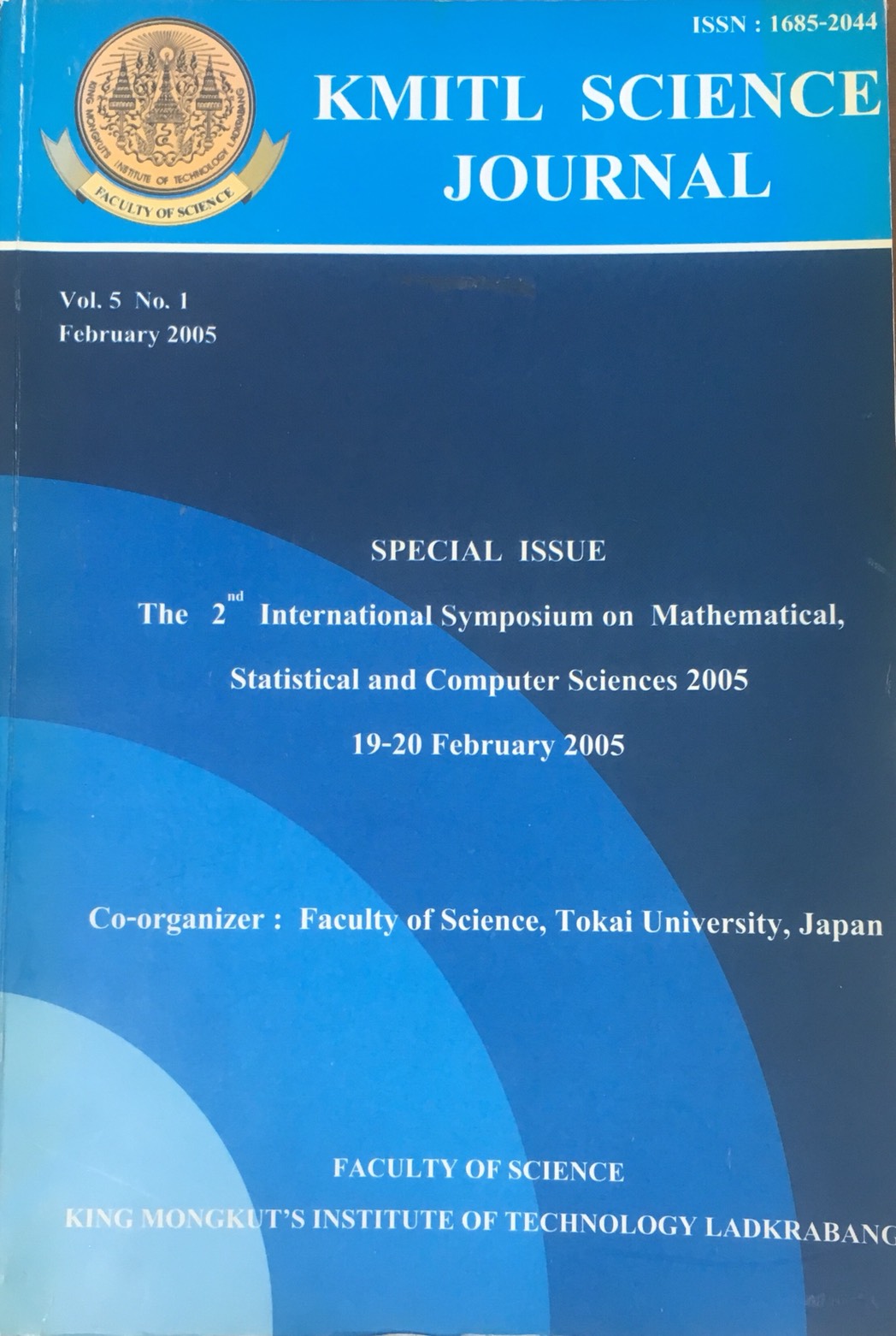Element Stretching for a Newtonian Fluid
Main Article Content
Abstract
This paper presents the element-stretching problem for Newtonian fluid by finite element methods (FEM) under the semi-implicit Taylor-Galerkin pressure correction principle. The assumptions of incompressible fluid; no gravitational effect, and temperature independence are used. The two-dimensional governing equations, in which the equations are nonlinear partial differential equations, are derived through the conservation of mass and momentum.
The configuration of mesh, which is elaborately and dominantly biased, can reflect true stetching behaviors. In the paper, the variation of velocities, pressure, stresses, shear rate and extension rate have showed up to Hencky strain (ε) 1.92
The simulation programme has been created to compute the solutions, which utilize remeshing and interpolating techniques for increased accuracy of solutions. The results exhibit the same trend as the experimental solutions.
Keywords: Finite Element Method, Filament Stretching, Liquid Bridge
Corresponding author: E-mail: vimolrat.N@chula.ac.th
Article Details
Copyright Transfer Statement
The copyright of this article is transferred to Current Applied Science and Technology journal with effect if and when the article is accepted for publication. The copyright transfer covers the exclusive right to reproduce and distribute the article, including reprints, translations, photographic reproductions, electronic form (offline, online) or any other reproductions of similar nature.
The author warrants that this contribution is original and that he/she has full power to make this grant. The author signs for and accepts responsibility for releasing this material on behalf of any and all co-authors.
Here is the link for download: Copyright transfer form.pdf
References
[2] Tirtaatmadja V. and Sridha T., 1993. A Filament Stretching Device for Measurement of Extensional Viscosity, J. Rheol., 37, 1081-1102.
[3] Tirtaatmadja V. and Sridha T., 1995. Comparison of Constitutive Equations for Polymer Solutions in Uniaxial Extension, J. Rheol., 39, 1133-1160.
[4] Spiegelberg S.H., Abels D.C. and McKinley G.H., 1996. The Role of End-effects on Measurement of Extensional Viscosity in Filament Stretching Rheometers, J. Non-Newtonian Fluid Mech, 64, 229-267
[5] Solomon M.J. and Muller S.J., 1996. The Transient Extensional Behavior of Polystyrene-based Boger Fluids of Varying Solvent Quality and Molecular weight, J. Rheol., 40, 837-856.
[6] Sizaire R. and Legat V., 1997. Finite Element Simulation of a Filament Stretching Extensional Rheometer, Int. J. Non-Newtonian Fluid Mech., 77, 89-107.
[7] Yao M. and McKinley G.H., 1998. Numerical Simulation of Extensional Deformations of Viscoelastic Liquid Bridges in Filament Stretching Device, J. Non-Newtonian Fluid Mech., 79, 469-501.
[8] Gaudet S. and McKinley G.H., 1996. Extensional Deformation of Newtonian Liquid Bridges, Phys. Fluids., 8, 2568-2579.
[9] Gaudet S. and McKinley G.H., 1998. Extensional Deformation of Non-Newtonian Liquid Bridges, Comp. Mechs., 22, 461-476.
[10] Hassager O., Kolte M.I. and Renardy M., 1998. Failure and Non-failure of Fluid Filament in Extension, J. Non-Newtonian Fluid Mech., 76, 137-151.
[11] Kolte M.I. and Szabo P., 1999. Capillary Thinning of Polymeric Filaments, J. Rheol., 43, 609-625.
[12] Ainser A., Carrot C., Guillet J. and Sirikov I., 2000. Transient Viscoelastic Analysis of Falling Weight Experiment, XIIIth Int. Cong. Rheol., Cambridge, UK, 2, 259-261.
[13] Chandio M.S., Matallah H. and Webster M.F., 2003. Numerical Simulation of Viscous Filament Stretching Flows, Int. J. Num. Meth. Heat Fluid Flow, 13, 899-930.
[14] Townsend P. and Webster M.F., 1987. An Algorithm for the Three-dimensional Transient Simulation of Non-Newtonian Fluid Flows, Proc. NUMERTA 87.
[15] Hawken D.M., Tamaddon-Jahromi H.R., Townsend P. and Webster M.F., 1990. A Taylor-Galerkin Based Algorithm for Viscous Incompressible Flow, Int. J. Num. Meth. Fluids, 10, 327-351.
[16] Sujatha K.S. and Webster M.F., Transient Simulation for Nano-scale Filament Stretching with Large Deformation-rates, Research progress report, Department of Computer Science, University of Wales, Swansea.
[17] Rivlin R.S. and Eriksen J.L., 1955. Stress Deformation Relations for Isotropic Material, J. Rat, Mech. Anal., 4, 323-425.
[18] Reiner M., 1960. Deformation Strain and Flow, Wiley, New York.
[19] Donea J., 1984. A Taylor-Galerkin Method for Convective Transport Problems, Int. J. Num. Meth. Eng., 20, 101-119.
[20] Crank J. and Nicolson P., 1947. A Practical Method for Numerical Evaluation of Solution of Patial Differential equations of the Heat-conduction Type, Proc. Camb. Phil. Soc., 43, 50-67.
[21] Reddy J.N., 1984. An Introduction to the Finite Element Method, McGraw-Hill.
[22] Townsend P. and Webster M.F., 1991. A Comparison of Gradient recovery methods in Finite Element Calculations, Comm. Appl. Num. Meth., 7, 195-204.
[23] Levine N., 1983. Superconvergent Recovery of the Gradient from Finite Element Approximation on Triangles, Technical report Num. Anal. Rep. 6/83, University of Reading, U.K.
[24] Levine N., 1985. Superconvergent Estimation of the Gradient from Linear Finite Element Approximation of Triangular elements, Ph.D. Thesis, University of Reading, U.K.
[25] Boroomand B. and Zienkiewicz O.C., 1997. An Improve REP Recovery and the Effectively Robustness test, Int. J. Num. Meth. Eng., 40, 3247-3277.
[26] Zienkiewicz O.C. and Zhu J.Z., 1995. Superconvergent and Superconvergent patch Recovery Finite Element in Analysis and Design, 19, 11-23.
[27] Matallah H., 1998. Numerical Simulation of Viscoelastic Flows, PH.D. Thesis, University of Wales Swansea, U.K.
[28] Levich V.G., 1962. Physicochemical Hydrodynamics, Prentice-Hall Engleword Cliffs, N.J.
[29] Keunings R., 1985. An Algorithm for the Simulation of Transient Viscoelastic Flows with Free Surface, J. Comp. Phys., 62, 199-220.
[30] McKinley G.H., 1995. Steady and Transient Motion of a Sphere Sedimenting Through Shear-thinning and Constant-viscosity Elastic Fluids, BSR Annual Award Lecture, IX th International Workshop on Numerical Methods in Non-Newtonian Flows.


